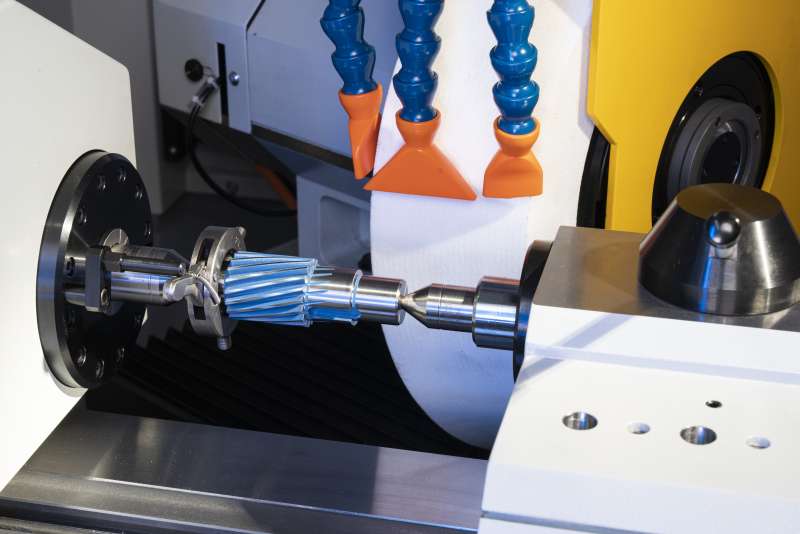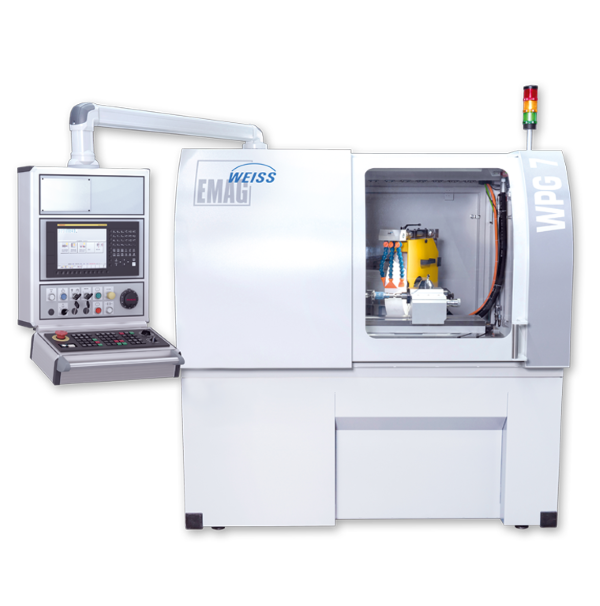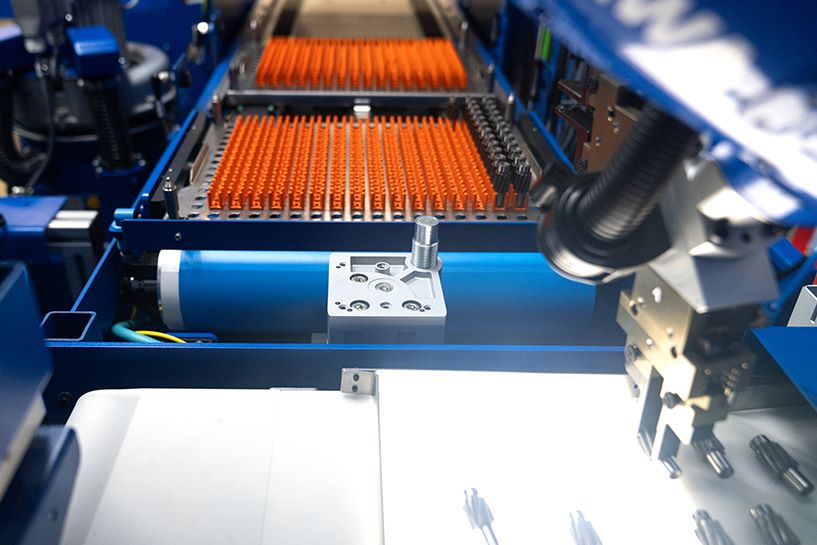A new, compact grinding machine being presented at IMTS 2024 promises great things.
EMAG sponsored this post.

For shop owners, there are few metrics that give them more sleepless nights than the cost per part. It doesn’t matter if they focus on high volume, small batch or medium sized jobs; if they have to produce a part, the economics of that part is of utmost importance.
With this in mind, EMAG will be introducing its latest grinding machine, the WPG7, at this year’s IMTS. Engineering.com met with Bernd Dürr, head of the company’s grinding business, and Andreas Hessling, technical sales manager for universal grinding machines, to discuss the benefits of this new equipment and its impact on owners and production managers of small, medium and large contract shops that produce grinding parts such as small shafts and pinions.
Affordable, versatile, compact and easy to install
Dürr points out that the WPG7 is very versatile. It can grind pinions, shafts and other parts up to a maximum weight of 30 kilograms. The parts can be up to 250 mm long, with a center height of 100 mm and a swing diameter of 200 mm. It can also achieve accuracies in the micrometer range. In addition, thanks to high-speed grinding, it can machine parts in a matter of seconds.
Hessling explains that a conventional grinding machine that would machine parts with this geometry, accuracy and speed can require two to three times more floor space than the WPG7.
“One advantage of the machine is that it takes up little space,” agrees Dürr. “It’s more or less a very small machine.”
The size of the machine was kept to a minimum by integrating much of the grinding process into a small hood. Positioning, measurements, grinding, dressing, lubrication and coolant are all performed in the same enclosure. Another way to keep the size of the machine small was to forego the ability to pivot the positioning of the grinding wheel. This allows customers to choose between two versions of the WPG7: one that can make straight plunge cuts at zero degrees and another that has an angled plunge cut at 30 degrees. Other machines that pivot to make different grinding cuts have to be much larger to allow this movement.

Although the WPG7 does not have a pivoting wheel, it is flexible in other ways. For example, it is compatible with cubic boron nitride (CBN) and corundum grinding wheels with a diameter of 500 millimeters and a grinding width of 80 mm. “That’s a big advantage,” says Hessling, “that we can use both technologies on this machine.” He pointed out that this is not standard in the industry. The ability to “mix it up” depending on which wheel is best for a particular application is a bonus.
From an installation perspective, the WPG7 is certainly in a class of its own. While other manufacturing equipment can take weeks or months to install, EMAG’s grinding machine takes just a few hours to install.
“A big advantage is that you only have to pick up the new machine from the truck with a forklift,” explains Dürr. “Then you put it in its place, connect power and air… then you prepare the coolant tank and then you can start the machine straight away.”
Automated for medium and large batch job shops
The WPG7 can be operated manually to optimise small-batch production in workshops, or it can be fully automated to produce more than 250,000 parts per year. Automation involves installing a gantry to pick parts from standard and custom conveyors, robots or grippers. The gantry then places the parts in the work area before returning them to the larger manufacturing flow once grinding is complete. This all happens in a matter of seconds.

Dürr adds that the ability to automate the machine is a huge advantage as it not only reduces cycle times but also allows the machine to run without an operator. He notes that it is currently difficult to find a good operator, so by automating the machine, fewer operators are needed to do the same amount of work.
In automated mode, the WPG7 controls the path of the grinder, the balancing of the wheel and measures each part to ensure accuracy and safety. This is important to Hessling because it can make a workshop very effective, productive and in demand. “If we want to keep production in our countries, we need to have automated, faster systems.” He says that the equipment “also needs to be designed compactly because floor space costs a lot of money. This way you can have smaller workshops and achieve the same productivity.”
Easy to use for small batch job shops
For smaller batch job shops, the full automation of the WPG7 may not make sense, but the equipment can still optimize productivity for these companies.
In this case, it may be faster for an operator to enter the part, set up the machine path, and repeat if necessary. To improve operator productivity, the WPG7 features a streamlined workflow and user interface.
For example, traditional operators may have to struggle with programming the grinding paths and cycles using complex Computerized Numerical Control (CNC) codes (such as G-code or FANUC). However, EMAG addresses this problem by pre-programming various grinding cycles into the WPG7 that are compatible with FANUC codes.
Hessling explains: “You select the cycle and then another page opens. You just have to enter the size of the workpiece from the drawing, measure the length of the diameter, enter diameter tolerances, the size of the grinding wheel, the width, the technology parameters (feed, material, cutting speed, etc.) – everything the operator already knows exactly. And then you select ‘Run’. When you enter all these numbers and information, the CNC program is fully generated. This is another important point to save time and productivity.”
In other words, with a few simple inputs from an operator, the WPG7 generates its own control code. And to increase productivity, this code can be saved and reused if a particular part is ever reordered. In this case, operators just need to enter the parts, find the correct code and click “run.” The control system can also work with both metric and imperial measurements.
Simplifying work processes in the workshop
Another technology that makes the WPG7 easier to operate and automate is the automatic balancing mount for the grinding wheel. As the machine continues to run, “the wheel gets smaller and smaller and some water might get into the wheel,” Hessling says. “When that happens, it creates some imbalance.” To fix this, he says, “the balancing head constantly adjusts the wheel so you always have a good, balanced wheel. That’s very important for good product quality and finishes. It should be very accurate.”
The WPG7 also features an acoustic gap crash sensor. As the wheel moves along its tool path, it generates noise that can be measured. The machine software expects a lot of noise when grinding and little noise when the wheel is spinning in the air.
Therefore, based on the tool path and part positioning, the software can listen for the noise generated to optimize the path, reduce the distance between the part and the wheel, or stop the machine if it detects a noise at an unexpected moment – indicating an accident.
Hessling explains that data from this sensor can also be used to speed up an automated feed system to save time between grinding parts. Reducing the time between each part by a few seconds may not sound like much, but when a shop processes 150,000 parts per year, that time slowly adds up to several days.
If you need grinding equipment, you should see it at IMTS 2024
At IMTS 2024, EMAG can demonstrate to industry leaders first-hand that the benefits of the WPG7 go beyond its compact size.
“The most important thing about this new system from EMAG is the cost per part,” summarizes Dürr. “That means very short loading time, very short operating time, very good dimensions, always within the tolerance range and the machine can run without an operator. Because the company owner saves money, he is competitive. That is the benefit.”
To see for yourself, visit the EMAG booth at IMTS 2024 or contact the specialists for a demo.
